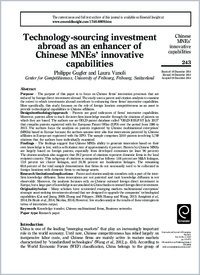Technology-Sourcing Investment Abroad as an Enhancer of Chinese MNEs’ Innovative Capabilities
- Gugler, Philippe University of Fribourg
- Vanoli, Laura University of Fribourg
-
2015
Published in:
- International Journal of Emerging Markets. - Emerald. - 2015, vol. 10, no. 2, p. 243-271
English
Purpose – The purpose of this paper is to focus on Chinese firms’ innovation processes that are induced by foreign direct investment abroad. The study uses a patent and citation analysis to examine the extent to which investments abroad contribute to enhancing these firms’ innovative capabilities. More specifically, this study focusses on the role of foreign location competitiveness as an asset to provide technological capabilities to Chinese affiliates. Design/methodology/approach – Patents are good indicators of firms’ innovative capabilities. Moreover, patents allow to track the inter-firm knowledge transfer through the citations of patents on which they are based. The authors use an OECD patent database called “OECD REGPAT July 2013” that compiles patents registered with the European Patent Office (EPO) over the period from 1986 to 2013. The authors focus the analysis on patents registered by Chinese multinational enterprises’ (MNEs) based in Europe because the authors assume inter alia that innovations patented by Chinese affiliates in Europe are registered with the EPO. The sample comprises 3,010 patents involving 5,749 citations that the authors have individually examined. Findings – The findings suggest that Chinese MNEs ability to generate innovation based on their own knowledge is low, with a self-citation rate of approximately 4 percent. Patents by Chinese MNEs are largely based on foreign patents, especially from developed economies (at least 90 percent). The citation analysis also suggests that 39.2 percent of citations represent domestic firms in the local recipient country. This subgroup of citations is categorized as follows: 1.04 percent are M&A linkages, 13.8 percent are cluster linkages, and 24.36 percent are localization linkages. The remaining 60.8 percent of the total sample demonstrates that firms do not necessarily need to be collocated in foreign locations with domestic firms to exchange assets. Research limitations/implications – Patent and citation analysis considers only a part of the interfirm knowledge diffusion. Some innovations are not patented and tacit knowledge diffusion is not observable. Moreover, the analysis focusses only on Chinese outward foreign direct investment to Europe, but a large part of knowledge is accumulated in China thanks to inward foreign direct investment. Originality/value – Many scholars have scrutinized emerging markets multinational enterprises’ strategic asset-seeking investments abroad that are designed to upgrade the companies’ technological capabilities (Cui and Jiang, 2009; Zhang and Filippov, 2009; Huang and Wang, 2013; Amighini et al., 2014; De Beule et al., 2014; Nicolas, 2014). However, few studies analyze the results of these strategies in terms of innovation output.
- Faculty
- Faculté des sciences économiques et sociales et du management
- Department
- Département d'économie politique
- Language
-
- English
- Classification
- Economics
- License
-
License undefined
- Identifiers
-
- RERO DOC 333223
- DOI 10.1108/IJOEM-12-2014-0217
- Persistent URL
- https://folia.unifr.ch/unifr/documents/309540
Statistics
Document views: 129
File downloads:
- Document: 352
